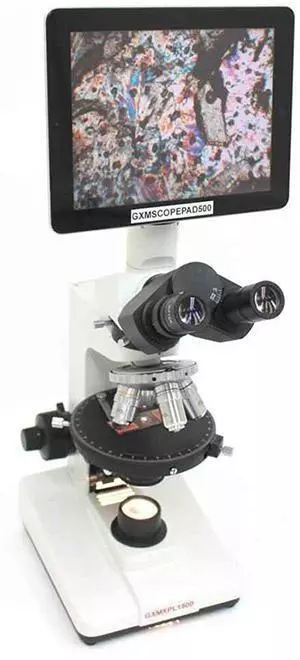Polarising Microscopes
Specialised in optical microscopy, polarising microscopes utilise polarised light properties for the analysis and observation of physical characteristics in specimens. Widely employed in geology, mineralogy, metallurgy, and biology, these microscopes facilitate the study of internal structures and compositions of various materials.
The Standard Microscope Model stands out as a sophisticated instrument, featuring top-tier components. Equipped with infinity optics, a trinocular head, and high-quality objectives offering a magnification range of 40X to 600X (with an optional extension up to 1000X), this model also includes a measurement reticle in one of the eyepieces for precise centring, along with a focus adjustment mechanism for added convenience.
This model boasts exceptional polarisers, ensuring outstanding extinction results when using crossed polars. The fully corrected optics prevent colour changes during adjustments in viewing angles, providing a consistent viewing experience. Additionally, an adjustable condenser with 30W illumination sources, Koehler illumination, and coarse/fine focus knobs featuring limit stoppers and tension adjustment enhance the microscope's functionality. The robust frame ensures stability, making it ideal for photomicrography.
Our collection of Polarising Microscopes caters to diverse needs, offering transmitted light, incident light, and dual-illuminated models. Advanced models feature cutting-edge elements such as waveplate inserts and Bertrand lenses, enabling in-depth analyses like conoscopy for highly accurate results. These microscopes empower users across various disciplines to conduct sophisticated studies with confidence.
Applications and Advantages of Polarising Microscopes
Polarising microscopes find widespread applications and offer numerous advantages over other optical microscope types. Key applications and benefits include:

- Mineral and Geological Analysis: Widely used in geology and mineralogy to study the internal structure and composition of minerals and rocks, particularly for analysing birefringence and optical properties.
- Metallurgical Analysis: Employed in metallurgy to analyse the microstructure of metals and alloys, aiding in the identification of phases and grain structures.
- Biological Analysis: Used in biology for studying the structure and composition of biological tissues and fibers, particularly valuable for analysing the birefringence of biological specimens.
- Improved Image Quality: Polarising microscopes produce high-quality images with excellent contrast and clarity, thanks to the use of polarised light, reducing scattered light for enhanced image quality.
- Enhanced Analysis: Offering advanced analysis capabilities, including determining the optical axis of specimens and analysing crystal form and birefringence, polarising microscopes provide comprehensive insights.
Polarising microscopes, with their versatility and advanced capabilities, are powerful tools for analysing and observing specimen properties across various scientific disciplines. Whether you're a geologist, mineralogist, metallurgist, or biologist, our range of polarising microscopes ensures you have the necessary tools for achieving optimal results.
| Type/Head | Eyepieces and Objectives |
|---|---|
| Monocular Transmitted | 10X FN18 Eyepiece, 4X, 10X, 40X DIN. Achromatic Objectives.Coaxial coarse/fine focus system minimum division of fine focusing: 2μm. 360° rotatable stage and rotatble polariser. Rotatable stage (Diameter 120mm). |
| Binocular Transmitted | 10X Widefield FN18 Eyepieces, 4X, 10X, 40X & 100X oil. Achromatic Objectives. Optional Objectives: 20X & 40X. 6V 20W Adjustable Halogen. Brinocular Head with interpupiliary adjustment and diopter adjustment for the eyepiece tubes. Coarse/Fine focus mechanism, limit stopper and tension adjustment. 360° rotatable 30mm x 40mm travel, centerable. |
| Trinocular Transmitted | 10X Widefield FN20 Eyepieces, 4X, 10X, 20X & 40X. Achromatic Objectives. Optional Objectives: 60X &100X oil. 6V 20W Adjustable Halogen. Trinocular Head suitable for use with a camera (requires the appropriate adaptor) with interpupiliary adjustment and diopter adjustment for the eyepiece tubes. Coarse/Fine focus mechanism, limit stopper and tension adjustment. 360° rotatable 30mm x 40mm travel, centerable. |
| 10X Widefield Eyepieces, 4X, 10X, 40X, 60X. 4 Plan Achromatic, POL Objectives. Trinocular head with interpupillary distance adjustment. 5MP ScopePad attaches via C-mount adaptor to the trinocular. photoport. Coaxial Coarse/Fine Focus Mechanism, Tension Adjustable, Limit Stopper | |
| 10X Widefield Eyepieces, 5X, 10X, 40X, 60X. 4 Plan Achromatic Objectives. 30W halogen lamp with adjustable intensity. Substantial Stand, with coaxial Coarse/Fine Focus Mechanism, Tension Adjustable, Limit Stopper. 30 degree inclined eyepiece tubes, with interpupillary distance adjustment. 5MP ScopePad attaches via C-mount adaptor to the trinocular photoport |
Principles of Polarising Microscopy
Polarised light, oscillating in a single plane, is employed in polarising microscopes. A polariser generates polarised light directed toward the specimen, and the light passing through is analysed by a second polariser, the analyser. Manipulating the orientation of these elements allows for determining the optical properties of the specimen, such as birefringence and optical axis.
Components of a Polarising Microscope
A polarising microscope typically consists of the following components:
- Polariser: Produces polarised light
- Specimen stage: Platform for mounting the specimen
- Eyepiece: Magnifies the image for observation
- Objective lens: Forms an image of the specimen
- Analyser: Second polariser analysing light passing through the specimen
- Bright field illumination: Light source illuminating the specimen
- Bertrand lens: Observes crystal form and determines the optical axis
